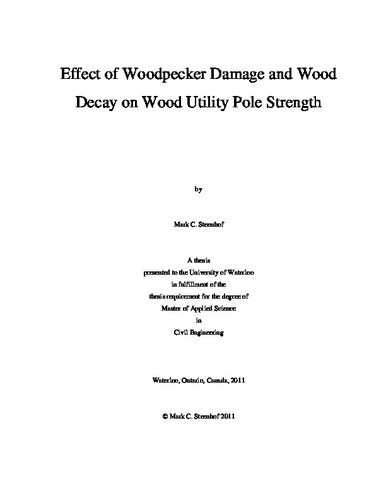| dc.description.abstract | In many regions of North America, Europe, and Australia, wood utility poles are used as main and secondary structural members for the support of electrical distribution and transmission lines. In the province of Ontario alone there are over 40000 H-frame, 6000 Gulfport, and thousands of single pole structures constructed of over 2 million wood utility poles (Pandey et al. 2010b). Currently, utility companies report an increasing number of woodpecker damage incidents on in-service utility poles (HONI 2010). In addition, many aging poles have woodpecker damage in combination with wood decay. Both these forms of degradation cause strength reductions in utility poles, making their structural integrity questionable. This has raised concerns regarding the safety of utility maintenance workers and the public, and the dependability of the electrical network.
In response to these concerns, Hydro One Networks Incorporated (HONI) initiated a research project on the effect of woodpecker damage and wood decay on wood utility pole strength. The objective of the research was to develop methods of quantifying the strength reduction caused by woodpecker damage and wood decay. This information was then used to develop in-service assessment methods for determination of whether pole replacement is necessary when specific levels of woodpecker damage and wood decay are present. By developing better assessment methods, in-service utility poles will not be unnecessarily replaced, reducing maintenance costs.
In this study, three analytical models were developed that predicted the theoretical cross-sectional strength reduction caused by the presence of woodpecker damage. A bending failure model was developed since, in the structural design of utility poles, bending moment stresses are known to be the critical design parameter. It was decided that the significance of shear stress in a cross-section should also be considered since the presence of woodpecker damage could cause shear stresses to be a significant parameter. As a result, a shear-bending and a shear failure model was developed to determine the significance of shear stress on cross-section behaviour. These models were developed for analysis purposes and were verified by the subsequent experimental program. A total of 28 new and in-service utility poles were received from HONI for experimental testing. The new poles were received in as-new condition, while the in-service poles received had varying levels of woodpecker damage and wood decay. The poles received were cut into 4.25 m lengths for beam testing. A single new pole and in-service specimen from each pole was tested as a control specimen without woodpecker damage to obtain reference utility pole bending strengths. The remainder of the new pole specimens were mechanically introduced with woodpecker damage, while the remainder of the in-service specimens were tested with natural woodpecker damage. The tested specimens were analyzed and the results were compared with the woodpecker damage analytical model predictions. Results indicated that the effect of woodpecker damage is well modelled by the woodpecker damage analytical models. Overall, the bending failure analytical model was preferable for cross-section analysis due to the accuracy of the model predictions and the simplicity of required calculations. It was evident from the experimental program that the presence of woodpecker damage can severely reduce the strength of utility poles, making replacement necessary according to CSA C22.3 No. 1 Cl. 8.3.1.3 (2006a). In-service specimen experimental results indicated that if wood decay is detected in wood utility poles, severe reduction in wood strength has occurred and the utility pole should be replaced.
Analytical and experimental results were used to develop three application methods for determining whether utility pole replacement is necessary due to the presence of woodpecker damage. These three methods include the simplified method, the chart method, and the case-specific method. The simplified method allows determination of whether a utility pole should be replaced based only on knowledge of the most severe level of woodpecker damage present in a pole. The chart method takes into account additional factors such as the diameter of the pole at the location of the woodpecker damage and the width of the hole opening. The case-specific method is advantageous since it accounts for the parameters used in the chart method and allows the location of woodpecker damage along the length of a pole to be accounted for. The simplified and chart methods are preferable since they are relatively simple and easy to implement in the field. The case-specific method requires a full structural analysis of the utility pole in question to be undertaken and is useful for more accurately assessing whether replacement is necessary. These three methods show how the research completed can be used for improved assessment of in-service utility poles resulting in reduced unnecessary pole replacement and maintenance costs. | en |

